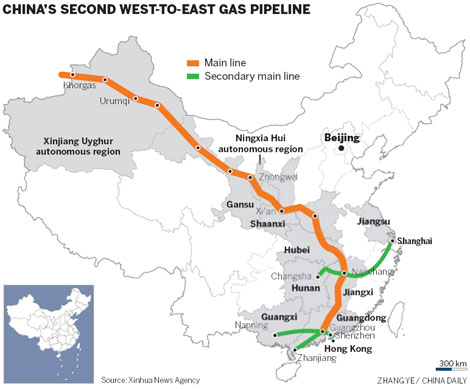Turkmenistan to expand natural gas supply to China
Updated: 2011-11-25 09:02
By Zhou Yan and Wang Qian (China Daily)
|
|||||||||||

SHENZHEN / BEIJING - Turkmenistan plans to expand its natural gas supply to China to 65 billion cubic meters (cu m) annually via pipelines, supporting China's rising demand for the fuel and its efforts to cut emissions.
Turkmen President Gurbanguly Berdymukhamedov revealed the figure on Thursday in Shenzhen, without giving a specific timeline.
China and Turkmenistan signed agreements in July 2007 under which the Central Asian country was to supply 30 billion cu m of gas to China annually through pipelines for 30 years.
As of Thursday, China had received 17.5 billion cu m of gas from Turkmenistan in almost two years, accounting for more than half of the country's total gas imports, according to Liao Yongyuan, vice-president of China National Petroleum Corp (CNPC), the pipeline operator.
The gas is shipped through the China-Central Asia pipeline, which originates in Turkmenistan and goes through Uzbekistan and Kazakhstan before connecting to China's second west-east gas pipeline. The latter line starts in the Xinjiang Uygur autonomous region and ends in Hong Kong, with a total length of 8,704 kilometers (km).
China's first cross-border pipeline opened in December 2009, and it is expected to reach Hong Kong in the second half of 2012. Guangdong province received fuel through the pipeline on Thursday, Liao said.
China and gas-rich Turkmenistan issued a joint statement on Wednesday in Beijing saying that they would establish a long-term, stable and strategic energy partnership.
China is stepping up efforts to diversify its energy imports. The country is also negotiating with Russia to import 68 billion cu m of natural gas annually through two pipelines.
In addition, China is accelerating the expansion of liquefied natural gas (LNG) terminals along the coast to import gas through tankers.
According to the National Development and Reform Commission, natural gas imports rose 86.5 percent year-on-year to about 25 billion cu m in the first 10 months, with 12.3 billion cu m coming from Central Asia. The remainder was imported as LNG.
According to Wang Yang, the governor of Guangdong, one of the country's most prosperous regions, the province's demand for gas is expected to reach 60 billion cu m by the end of 2020, against 9 billion cu m in 2010.
The second west-to-east pipeline, costing an estimated 142.2 billion yuan ($22.4 billion), is just part of a massive national plan for delivering natural gas.
The first pipeline in the national network has a length of 4,200 km and connects Xinjiang and Shanghai. It opened in October 2004 with 12 billion cu m of annual designed transmission capacity.
"We will build up the third and fourth pipelines in the future to further expand gas supply, in particular to the middle, southeastern coastal and southern parts of China," Liao said.
China Daily had reported that the third pipeline is expected to open by the end of 2013 and carry about 30 billion cu m of gas annually, mainly from Central Asia to Fujian province.
China, the world's biggest energy consumer, will also accelerate its domestic oil and gas output.
"China will enter a booming age in the petroleum and gas industry in the coming 20 years, with oil and gas output rising from 280 million tons of oil equivalent in 2010 to 450 million tons by 2030," Peng Qiming, director of the Department of Geological Exploration of the Ministry of Land and Resources, said on Thursday.
China is also accelerating preparations for offshore oil and gas exploration in the northern part of the South China Sea, which will benefit the eastern coastal areas, said Che Changbo, vice-director of the Strategic Research Center of Oil and Gas Resources under the ministry.








